Related Research Articles
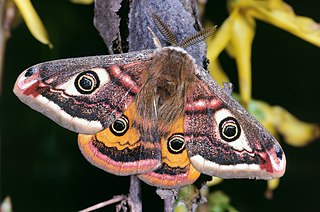
Saturniidae, members of which are commonly named the saturniids, is a family of Lepidoptera with an estimated 2,300 described species. The family contains some of the largest species of moths in the world. Notable members include the emperor moths, royal moths, and giant silk moths.
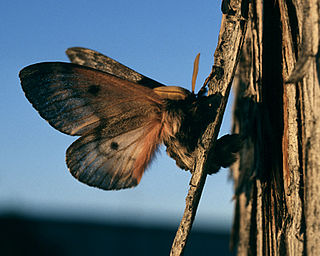
Coloradia is a genus of moths of the family Saturniidae. There are nine described species found in Mexico and eastern North America. The genus was first described by C. A. Blake in 1863.

Saturnia is a genus of large silkmoths in the family Saturniidae, which the German biologist Franz von Paula Schrank first described in 1802. Its members are commonly named emperor moths, though this is also used for various close relatives in subfamily Saturniinae. Most species are Palearctic, but three, commonly called "saturnia moths", inhabit the chaparral of California: S. mendocino, S. walterorum, and S. albofasciata.

Citheronia sepulcralis, the pine-devil moth, is a Nearctic member of the family Saturniidae and of the subfamily Ceratocampinae. The species are blackish brown. The species was first described by Augustus Radcliffe Grote and Coleman Townsend Robinson in 1865.

Antherina is a monotypic moth genus in the family Saturniidae erected by William Elford Leach in 1815. Its only species, Antherina suraka, the Suraka silk moth, was first described by Jean Baptiste Boisduval in 1833. It is found on Madagascar and Mayotte. Both larvae and pupae consumed in parts of Madagascar, but not to a great extent. The larvae feed on oleander, privet, willows, beech, Liquidambar, Crataegus (hawthorns), grapevine, lilac, cherry, laurel, Forsythia, Rhus, Pistacia, apple, pear, plum and peach leaves, but foodplants differ from species to species. They start off black with yellow protrusions to eventually green with red and yellow on their bodies. Once they've finished growing they will be as thick as your finger and when they have reached their final days as a caterpillar they will develop a blue dorsal stripe and wander around looking for a place to pupate.
Eochroa is a monotypic moth genus in the family Saturniidae erected by Felder in 1874. Its only species, Eochroa trimenii, was also described by Felder in the same year. They inhabit arid rocky areas and mountain passes in Africa where the host plant grows.
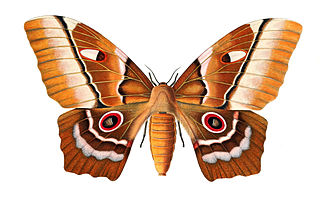
Pseudimbrasia is a monotypic moth genus in the family Saturniidae described by Pierre Claude Rougeot in 1962. Its only species, Pseudimbrasia deyrollei, described by James Thomson in 1858, is found in the mid-latitudes of Africa.

Automeris is a genus of moths in the family Saturniidae and the subfamily Hemileucinae. As of 1996 there were 124 species, and more have since been described. These moths are generally characterized by the eyelike patches on the hindwings and the leaflike pattern on the forewings, an example of crypsis. The genus was first described by Jacob Hübner in 1819 and it is distributed in the Neotropical realm.

Archaeoattacus is a genus of moths belonging to the family Saturniidae and subfamily Saturniinae. The species of this genus are present in the Himalayas, Sundaland and Peninsular Malaysia. The genus was first described by Watson in 1914.

Aglia is a genus of moths in the family Saturniidae first described by Ochsenheimer in 1810. It is the only genus in the subfamily Agliinae.

Cercophaninae is a subfamily of the family Saturniidae, and was, until recently, treated as a separate family, Cercophanidae.

Microdulia is a genus of moths in the family Saturniidae first described by Karl Jordan in 1924. It contains only one species, Microdulia mirabilis, described by Rothschild in 1895, which is found between 35° and 47°S in Chile and Neuquén in Argentina.

Adetomeris is a genus of moths in the family Saturniidae first described by Charles Duncan Michener in 1949.
Xanthodirphia is a genus of moths in the family Saturniidae first described by Charles Duncan Michener in 1949. It was originally established as a subgenus of the genus Ormiscodes.

Gynanisa is a genus of moths in the family Saturniidae first described by Francis Walker in 1855.

Urota is a monotypic moth genus in the family Saturniidae erected by John O. Westwood in 1849. Its single species, Urota sinope, was described by the same author in the same year. It was described from KwaZulu-Natal, South Africa.

Usta is a genus of moths in the family Saturniidae first described by Hans Daniel Johan Wallengren in 1863.
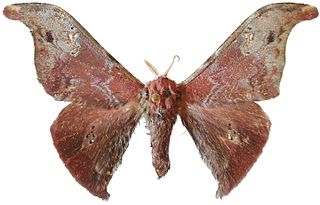
Carnegia is a genus of moths in the family Saturniidae first described by William Jacob Holland in 1896.
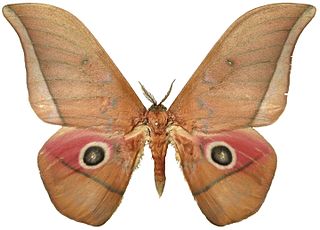
Lobobunaea acetes is a species of moth in the family Saturniidae first described by John O. Westwood in 1849. It is found in Angola, Cameroon, the Democratic Republic of the Congo, Guinea, Kenya, Nigeria, Rwanda, Sierra Leone, Tanzania and Uganda.
References
- ↑ Rougerie, R. & Collective of iBOL Saturniidae expert taxonomists (2009). "Online list of valid and available names of the Saturniidae of the World". Lepidoptera Barcode of Life.
- ↑ Pitkin, Brian & Jenkins, Paul (November 5, 2004). "Neocercophana Izquierdo, 1895". Butterflies and Moths of the World. Natural History Museum, London. Retrieved November 12, 2018.